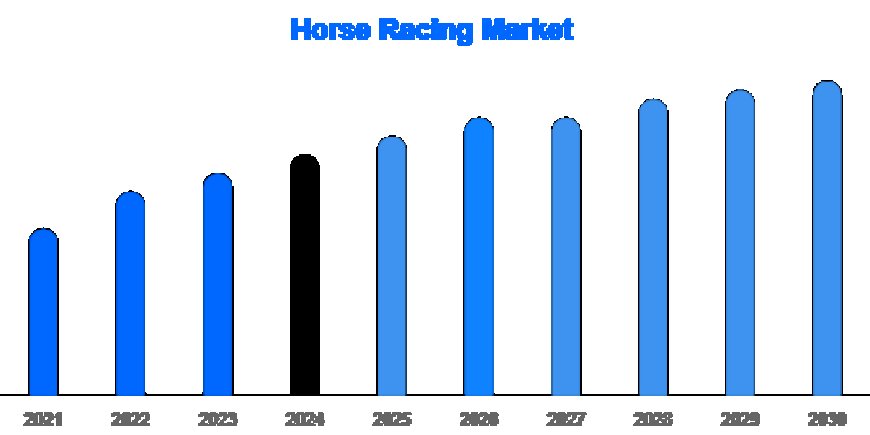Horse Racing Market: Trends, Challenges, Opportunities, Segmentation & Key Developments (2025-30)
The global horse racing market size was valued at USD 471.3 billion in 2024 and is projected to grow from USD 491.7 billion by 2025 to USD 530.2 billion by 2030

Market Overview
The globalhorse racing marketis experiencing a renewed surge in popularity, driven by technological innovations, expanded betting platforms, and increasing government initiatives to regulate and monetize the industry. In 2024, the market continues to attract attention from sports investors, digital betting companies, and even blockchain firms looking to revolutionize the traditional betting model.
With growing interest from emerging markets in Asia-Pacific, and a revival of interest in North America and Europe, the horse racing industry is undergoing a transformation toward digitization, transparency, and fan engagement.
The global horse racing market size was valued atUSD 471.3 billion in 2024and is projected to grow fromUSD 491.7 billion by 2025 to USD 530.2 billion by 2030, exhibiting a CAGR of3.9%during the forecast period (20252030).
Latest Market Trends
1. Rise of Digital Betting Platforms
One of the most notable trends in the market is the growing dominance ofonline horse race betting platforms. The integration of AI for predictive analytics, real-time odds monitoring, and mobile app enhancements have improved user experience and expanded the reach of horse racing beyond traditional race tracks.
2. Use of Data Analytics and AI
Advanced analytics tools are being adopted by race organizers and bettors alike. AI-driven models are helping bettors assess horse performance, while organizers use big data to optimize race schedules, breeding practices, and marketing strategies.
3. Blockchain and Smart Contracts
Blockchain is increasingly being used for betting transparency and fraud prevention. Smart contracts automate payouts and reduce human errors, thus boosting user trust in betting platforms.
4. Focus on Animal Welfare
Due to increasing scrutiny from animal rights organizations, the market is witnessing investments inhorse healthcare, track safety, and regulatory compliance. Tracks are being redesigned, and new regulations on horse drug testing have been implemented globally.
5. Immersive Viewing with AR/VR
Some race organizers have begun experimenting withAR/VR-based race viewingoptions. These technologies provide immersive experiences and are being tested as monetizable fan-engagement strategies, especially in regions with limited physical race tracks.
Market Challenges
1. Regulatory Inconsistencies
Each country has its own regulatory framework for gambling and horse racing, causing complications for international operators. These inconsistencies often affect market expansion strategies.
2. Concerns Over Animal Cruelty
Rising awareness of ethical treatment of racehorses has led to public backlash, forcing race organizers to invest heavily inanimal welfare practicesor risk losing their operating licenses and sponsors.
3. Declining Traditional Attendance
While digital betting has grown,physical attendance at race tracks has declined, especially among younger demographics. Organizers must innovate to attract Gen Z and Millennials to the live experience.
4. Cybersecurity and Fraud
With the growth of online betting platforms, theres also a rise in cyberattacks and fraudulent activities, urging platforms to invest inrobust cybersecurity infrastructures.
Opportunities in the Market
1. Mobile Betting Expansion
As mobile penetration increases in emerging markets, companies can tap into vast new user bases withlocalized apps and regional betting campaigns.
2. Equestrian Gaming and Fantasy Platforms
Horse racing-basedfantasy leagues and gaming appsare gaining traction. These platforms provide a new avenue for fan interaction and revenue generation.
3. Market Entry in Asia-Pacific and Africa
Countries like India, China, and South Africa presentuntapped opportunitiesdue to growing middle-class populations and increased internet access.
4. Sponsorships and Cross-Promotions
Market Segmentation Overview
A. By Type
-
Flat Racing: The most popular form globally, especially in the UK, USA, and Australia.
-
Jump Racing: Also known as National Hunt racing, prominent in the UK and parts of Europe.
-
Harness Racing: More common in the U.S., Canada, and Nordic countries.
B. By Application
-
Online Betting
-
Offline Betting
-
Race Day Revenue(ticketing, hospitality, merchandise)
C. By End Users
-
Race Organizers
-
Betting Companies
-
Racehorse Owners
-
Governing Bodies and Sponsors
Top Players and Recent Developments (20242025)
1. The Jockey Club
In 2024, The Jockey Club launched a real-timedata analytics platformfor race forecasting and invested in animal health R&D centers across North America.
2. Betfair
Betfair extended its reach in Southeast Asia with newmobile betting licensesand struck a partnership with an Indian digital payment company for localized betting access.
3. Flutter Entertainment
Flutter completed itsmerger with a leading Asian betting firmin early 2025, giving it strong market presence across APAC and boosting its mobile revenues by 17%.
4. Churchill Downs Inc.
The operator announced plans to invest over $50 million inupgrading racetracks with sustainable infrastructure, incorporating solar power and AI-driven maintenance systems.
5. TVG (FanDuel Racing)
TVG introduced aninteractive AR race viewing experience, available exclusively on FanDuel, capturing a new younger audience segment in Q1 2025.
Conclusion
The horse racing market is evolving at a rapid pace, blending tradition with technology to remain relevant in a fast-changing sports entertainment landscape. While regulatory and ethical challenges persist, the industrys embrace of digitization, data-driven decision-making, and customer-focused innovations provide a promising roadmap for future growth.
With increasing investments, global expansion, and the integration of immersive technologies, the horse racing market is expected to remain a lucrative space for stakeholders in the years ahead.
About Us
Deep Market Insights is a market intelligence company providing global business information reports and services. Our exclusive blend of quantitative forecasting and trends analysis provides forward-looking insight for thousands of decision-makers. Deep Market Insights provides actionable market research data, especially designed and presented for decision making and ROI.
Most Asked FAQs
1. Is horse racing still a profitable industry in 2025?
Yes, with the rise of digital platforms and global market expansion, the industry remains profitable, especially in online betting and event sponsorship.
2. What are the biggest challenges faced by the horse racing market?
Regulatory inconsistencies, animal welfare concerns, declining physical attendance, and cybersecurity threats are among the key challenges.
3. Which regions are seeing the most growth in horse racing?
Asia-Pacific and Africa are emerging as high-growth regions due to increasing digital penetration and rising disposable income.
4. Are online betting platforms safe for horse racing?
Yes, most major platforms use encryption and fraud prevention mechanisms. However, users should stick to regulated operators.
5. How are technologies like AI and blockchain impacting the market?
AI helps in data analytics and predictive modeling, while blockchain ensures transparent betting and secure payouts.




























